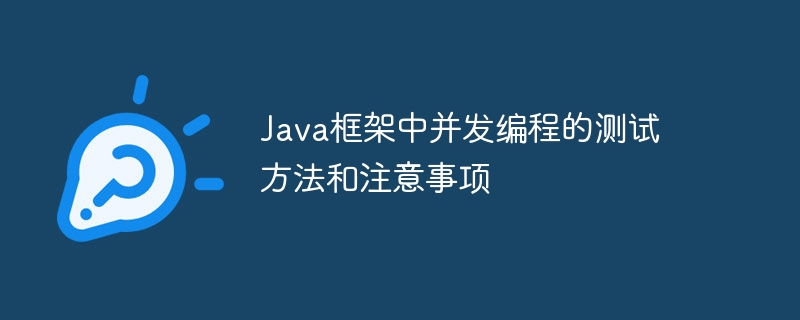在 java 框架中进行并发编程测试,需要采用特定的方法和注意事项,包括:单元测试:模拟外部依赖项,编写多线程测试(使用 @concurrent 注解指定并发线程数)。集成测试:在实际环境中执行测试,监视性能指标以检测并发问题。压力测试:模拟大量并发用户,分析资源消耗和响应时间以确定并发能力。注意事项:线程安全:确保对象和代码是线程安全的(使用 synchronized 和 volatile 关键字)。死锁:识别潜在死锁场景并采取预防措施(例如使用死锁检测算法)。状态竞争:避免在多个线程之间共享状态,必要时使用同步机制保护

Java 框架中并发编程的测试方法和注意事项
在 Java 框架中,并发编程至关重要,因为它可以提高应用程序的性能和可扩展性。然而,测试并发代码可能具有挑战性,需要特定的方法和注意事项。
方法
1. 单元测试
使用模拟框架(如 Mockito)模拟外部依赖项,以隔离并发代码。 编写多线程测试,使用 @Concurrent 注解来指定并发的线程数。2. 集成测试
使用分布式测试框架(如 TestNG 或 JUnit5)在实际环境中执行测试。 监视应用程序的性能指标(如吞吐量和响应时间)以检测并发问题。3. 压力测试
使用工具(如 JMeter 或 LoadRunner)模拟大量并发的用户。 分析应用程序的资源消耗和响应时间,以确定其并发能力。注意事项
1. 线程安全
确保对象和代码是线程安全的,可以使用 synchronized 和 volatile 关键字。2. 死锁
识别潜在的死锁场景并采用预防措施,例如使用死锁检测算法。3. 状态竞争
避免共享状态在多个线程之间共享。如果需要,请使用同步机制来保护共享数据。4. 顺序依赖
识别并发操作之间的顺序依赖性,并使用锁或同步屏障来确保正确执行。5. 内存可见性
确保对共享数据的写入对所有线程可见。使用 volatile 关键字或内存栅栏来确保内存可见性。实战案例
考虑一个使用 Java 并发队列(ConcurrentLinkedQueue)的应用程序。
单元测试:
1
2
3
4
5
6
7
8
9
10
11
12
13
14
15
16
17
18
19
20
21
22
23
24
25
26
27
import java.util.concurrent.ConcurrentLinkedQueue;
import org.junit.Test;
import org.mockito.Mockito;
public class QueueTest {
@Test
public void testConcurrency() throws InterruptedException {
ConcurrentLinkedQueue<Integer> queue = Mockito.mock(ConcurrentLinkedQueue.class);
Thread[] threads = new Thread[5];
for (int i = 0; i < threads.length; i++) {
threads[i] = new Thread(() -> {
for (int j = 0; j < 1000; j++) {
queue.offer(j);
}
});
threads[i].start();
}
for (Thread thread : threads) {
thread.join();
}
Mockito.verify(queue, Mockito.times(5000)).offer(Mockito.anyInt());
}
}
集成测试:
1
2
3
4
5
6
7
8
9
10
11
12
13
14
15
16
17
18
19
20
21
22
23
24
25
26
27
28
29
30
31
32
33
34
35
36
37
38
39
import java.util.concurrent.CountDownLatch;
import java.util.concurrent.TimeUnit;
import org.testng.annotations.Test;
public class QueueIntegrationTest {
@Test
public void testPerformance() throws InterruptedException {
ConcurrentLinkedQueue<Integer> queue = new ConcurrentLinkedQueue<>();
CountDownLatch latch = new CountDownLatch(1);
Thread producer = new Thread(() -> {
for (int i = 0; i < 1000000; i++) {
queue.offer(i);
}
latch.countDown();
});
Thread consumer = new Thread(() -> {
try {
latch.await(10, TimeUnit.SECONDS);
} catch (InterruptedException e) {
e.printStackTrace();
}
while (!queue.isEmpty()) {
queue.poll();
}
});
producer.start();
consumer.start();
producer.join();
consumer.join();
System.out.println("Average throughput: " + (1000000 / 10) + " items/second");
}
}
通过遵循这些方法和注意事项,您可以有效地测试 Java 框架中的并发编程,提高应用程序的可靠性和性能。
以上就是Java框架中并发编程的测试方法和注意事项的详细内容,更多请关注其它相关文章!
